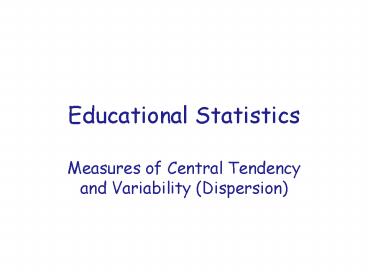Educational Statistics - PowerPoint PPT Presentation
1 / 26
Title:
Educational Statistics
Description:
Alka-Seltzer. 160. Sudafed. 115. Centrum. 150. What is the AVERAGE number of drug sales? ... Alka-Seltzer. 160. Sudafed. 115. Centrum. 150. What is the MODE of ... – PowerPoint PPT presentation
Number of Views:1720
Avg rating:3.0/5.0
Title: Educational Statistics
1
Educational Statistics
- Measures of Central Tendency and Variability
(Dispersion)
2
Over the Counter Drug Sales (in Millions)
3
Measures of Central Tendency
- Measures of central tendency tell us something
about the typicalness of a set of data. - Tell us what the typical score is in a
distribution of scores. - Three measures of central tendency
- Mode
- Median
- Mean
4
Measures of central tendencythe mode
- The mode is the score that occurs most frequently
in a distribution. - Sometimes more than one score occurs at
frequencies distinctively higher than other
scores, in which case there is(are) more than one
mode - Bi-modal distributions.
- Multi-modal distributions.
- Only appropriate measure of central tendency for
nominal data.
5
Over the Counter Drug Sales(in Millions)
6
Measures of central tendencythe median (Md)
- The median is the middle score in an ordered
distribution of scores. - It is the score that divides a distribution in
half. - It is also the score at the 50th percentile rank.
- The median can be found by computing the median
location (N 1)/2. - The median is the most appropriate measure of
central tendency for ordinal data.
7
Measures of central tendencythe median (Md)
- In the distribution given to the right, find the
median. - What is the percentile rank (PR) of a score of
13? - What is the score cor-responding to a percentile
rank of 29?
- Score Freq Cum. F c
- 6 2 2 3.8
- 8 5 7 13.5
- 9 0 7 13.5
- 10 8 15 28.8
- 11 11 26 50.0
- 12 9 35 67.3
- 13 6 41 78.8
- 14 4 45 86.6
- 15 5 50 96.2
- 16 2 52 100.0
8
Over the Counter Drug Sales (in Millions)
9
Measures of central tendencythe Mean (µ,M, or
)
- The most widely used measure of central tendency
- In words, the mean ( ) is the sum (S) of the
scores (the Xs) divided by the number of scores
(N).
10
Over the Counter Drug Sales (in Millions)
11
Measures of Central Tendency with special
Distributions
- The mode and bimodal distributions.
- For distributions with more than one mode, the
other measures of central tendency are
misleading. - The Median and skewed distributions.
- When a distribution is skewed the use of the mean
may be misleading - Skew can be determined by the relative positions
of the mean, median, and mode.
12
Measures of Variability
- How would you describe the variability in the
distribution of SAT-V scores given at the right? - In other words, how spread-out are the scores?
- Think about it.
- Write these values down.
13
Measures of Variability
- Three common measures of variability are
- The Range.
- The Variance.
- The Standard deviation.
- Other measures of variability are
- The interquartile range.
- The quartile deviation or semi-interquartile
range.
14
Measures of VariabilityThe Range (R)
- R The difference between the largest value in
the distribution and the smallest value in the
distribution. - I.e. R Xlargest Xsmallest.
- Compute the Range for the distribution given.
- R 175.
15
Measures of VariabilityThe Variance (Var)
- The variance is more computationally comples.
- Defined as the average squared deviation from the
mean of the distribution. - In symbols
16
Computing the Variance
- First, compute the sum
17
Computing the Variance
- First, compute the sum
- Then, divide by N
18
Computing the Variance
- Next, subtract the mean from each score (call
these deviations from the mean, or, d )
19
Computing the Variance
- Next, subtract the mean from each score (call
these deviations from the mean, or, d )
20
Computing the Variance
- Next, Square the deviations from the mean
21
Computing the Variance
- Next, Square the deviations from the mean
22
Computing the Variance
- Now, sum the squared deviations
- And divide by N
23
Measures of VariabilityThe Standard Deviation
- Generally, we would prefer a measure of
variability that tells us something about how
far, on average, scores deviate from the mean. - This is what the standard deviation tells us.
- Since the variance is the average squared
deviation from the mean, the standard deviation,
computed as the square root of the variance gives
us the average deviation from the mean.
24
Measures of VariabilityThe Coefficient of
Variation (CV)
- Distributions with larger means tend to have
larger variances (and SDs) than distributions
with smaller means. - The CV provides convenient way to compare the
variances of two or more distributions.
25
Using Statistics as Estimators
- We are rarely interested in sample statisticswe
are interested in population parameters. - Statistics are used to estimate (or make
inferences about) parameters. - The best statistics are sufficient, unbiased,
efficient, and robust (or resistant)
26
- End of Presentation































